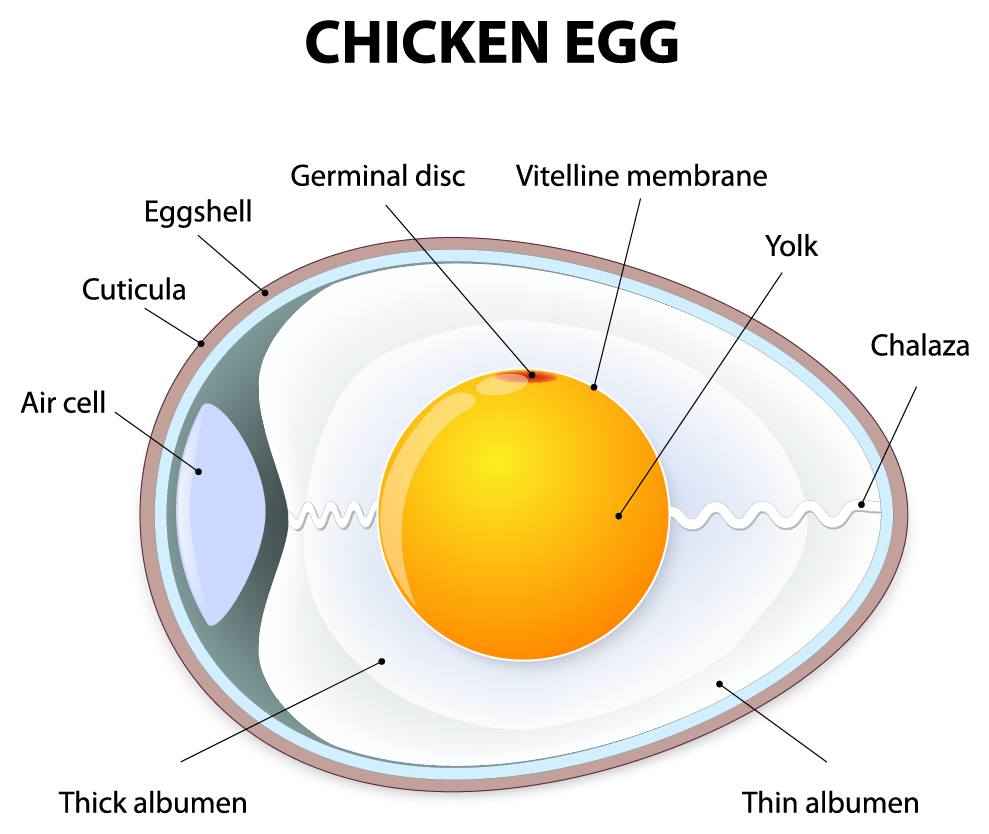A chicken egg is a reproductive body produced by a female chicken called a hen. It has been an important food source for humans for thousands of years. This comprehensive guide provides an overview of chicken eggs, how they are formed, their anatomy, and other key facts.
How Are Chicken Eggs Formed?
Chicken eggs begin their journey inside the hen’s ovary. The ovary holds small yolks inside structures called follicles. Once the yolk matures, the follicle ruptures and the yolk is released into the oviduct, which is a long, winding reproductive tube where the egg develops.
The egg spends about 15 minutes in the first part of the oviduct called the infundibulum, where fertilization can occur if sperm is present. It then moves into the magnum for 3 hours as the egg white proteins are added. In the isthmus, the shell membranes are added over 1 hour Finally, the egg reaches the shell gland, which takes a full day to complete the hard calcium carbonate shell Once finished, it exits the hen’s vent. The entire process takes 24-26 hours.
Key Parts of a Chicken Egg
A chicken egg contains the following key structures:
-
Shell – The hard outer covering made of calcium carbonate It comes in white or brown colors
-
Shell membranes – Two inner membranes that provide protection.
-
Albumen (egg white) – The clear liquid that surrounds the yolk, made mostly of protein and water.
-
Chalazae – White twisted strands that anchor the yolk.
-
Yolk – The yellow center made of fat, protein and vitamins to nourish a growing chick.
-
Germinal disc – A small white spot on the yolk that contains the hen’s genetic material. In fertilized eggs, this becomes the embryo.
Differences Between Fertilized and Unfertilized Eggs
The key difference between fertilized and unfertilized chicken eggs is that fertilized eggs can develop into chicks, while unfertilized eggs cannot.
-
Fertilized – Contain genetic material from a rooster and hen and can become chicks if incubated. Have a larger germinal disc.
-
Unfertilized – Contain only the hen’s DNA and will never hatch. Lack a rooster’s contribution. Most eggs consumed are unfertilized.
Both fertilized and unfertilized eggs are edible. Only fertilized eggs that are incubated for 21 days can yield baby chicks.
Nutrition Facts
Chicken eggs are packed with nutrients and relatively low in calories. Here are some of the nutrients found in a large 56g egg:
- Calories: 72
- Protein: 6g
- Fat: 5g
- Vitamin A: 6% DV
- Vitamin B12: 9% DV
- Vitamin B2: 15% DV
- Phosphorus: 9% DV
- Selenium: 22% DV
The protein found in eggs contains all 9 essential amino acids, making eggs a complete protein food. The fat is mostly unsaturated fat, plus vitamins A, B12 and B2.
Cooking Chicken Eggs
Chicken eggs are very versatile in cooking. Here are some of the most common ways to cook them:
-
Scrambled – Beat eggs and cook while stirring constantly. Often add milk, cheese or veggies.
-
Fried – Cook eggs in a pan with butter or oil. Can be sunny side up, over easy or hard.
-
Poached – Gently simmer eggs in water. Produces a soft, runny yolk.
-
Boiled – Cook eggs in boiling water. Produces a firm, cooked yolk.
-
Baked – Bake eggs in a muffin tin or ramekin. Great for making egg bites.
-
Omelets – Cook eggs mixed with ingredients like cheese, meat or veggies. Folded over.
Egg Safety and Storage
To safely handle eggs:
-
Refrigerate eggs after purchase and use within 3-5 weeks. The cold limits bacterial growth.
-
Cook eggs thoroughly until yolks and whites are firm. This kills any bacteria present like Salmonella.
-
Avoid consuming raw or undercooked eggs.
-
Discard eggs that are cracked as this allows entry of bacteria.
-
Wash hands and cooking tools after handling raw eggs to avoid cross-contamination.
Storing eggs pointy side down may also help preserve freshness longer by keeping the yolk centered.

Learn More About Egg Production in Australia
Eggs are produced using different methods with the three most common being free range, barn-laid, and cage. While each system has its advantages and disadvantages, the nutritional profile of the eggs is consistent across all systems.
Learn more about these different farming systems today or take Australian Eggs interactive tour of three commercial egg farms.
Frequently Asked Questions
The hen breeds used in commercial egg farming start laying eggs at around 16-18 weeks (four months) old. Commercial laying hens continue to produce first quality eggs until they are about one and a half years old.
How An Egg Is Made
FAQ
What exactly is an egg from a chicken?
An egg develops through multiple stages during its time inside a hen. A yolk is encased in layers of egg white and protective membranes, sealed within a shell and coated with a fast-drying protective fluid.
What is a chicken egg technically?
The avian egg, in all its complexity, is still a mystery. A highly complex reproductive cell, it is essentially a tiny center of life. Initial development of the embryo takes place in the blastoderm. The albumen surrounds the yolk and protects this potential life.
Is a chicken egg an ovary?
No. Egg yolks are not chicken ovaries. The chicken keeps it’s ovaries in it’s own abdomen. The egg is made up of albumen, the clear part. This is what grows into a chick. The yolk is the food for the chick while it is growing in the shell. I personally love the flavor of the yolks when fried, poached, or soft boiled.
Are eggs hens’ periods?
